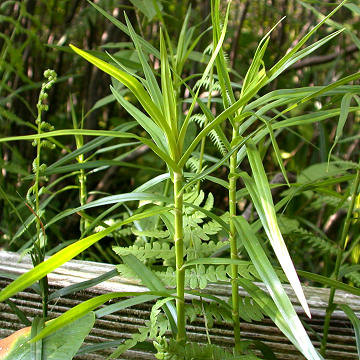

Dulichium arundinaceum - (image 1 of 5)
Taxonomy
Family: Cyperaceae
Habitat
Bogs and marshes. Sometimes found growing along the shores of still ponds and even in moist, open woods.
Associates
Asclepias incarnata, Biden cercua, Calamagrostis canadensis, Carex stricta, Cephalanthus occidentalis, Thelypteris palustris, Iris virginica, Polygonum amphibium stipulaceum, Typha latifolia. In bogs also with Osmunda regalis, Potentilla palustris, Vaccinium macrocarpon.
Distribution
Newfoundland west to MN, south to GL and TX; Also in the west from British Columbia to CA and MT.
Morphology
Rhizomatous perennial with erect, subterete, hollow, jointed, leafy stems to 1 m. Leaves numerous, the lower bladeless, the upper sheaths often overlapping; blades 5-15 cm long and 2.5-8 mm wide. Inflorescence axillary, the scape folded in half, mostly keeled, 2-ranked along rachilla; flowers mostly perfect; perianth bristles present; spikelets essentially alike. Achenes naked, not enclosed in a perigynium, conspicuously long-tuberculate.
Notes
Flowers early July to late August
Wetland indicator: Obligate
Another common name for this plant is Three-way Sedge. The name dwarf bamboo is one it seems to have picked up in the aquatic plant trade. It is certainly useful for the margins of a water garden.
References
Gleason, Henry A.
and A. Cronquist. 1991. Manual of Vascular Plants of Northeastern United States
and Adjacent Canada. Second Ed.
The New York Botanical Garden. Bronx, NY
Swink, F. and G. Wilhelm. 1994. Plants of the Chicago Region.
Indiana Academy of Science. The Morton Arboretum. Lisle, Illinois.
|
Michael Hough © 2004 |